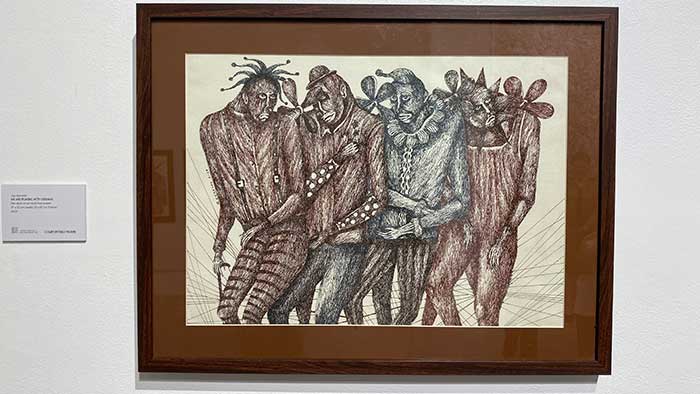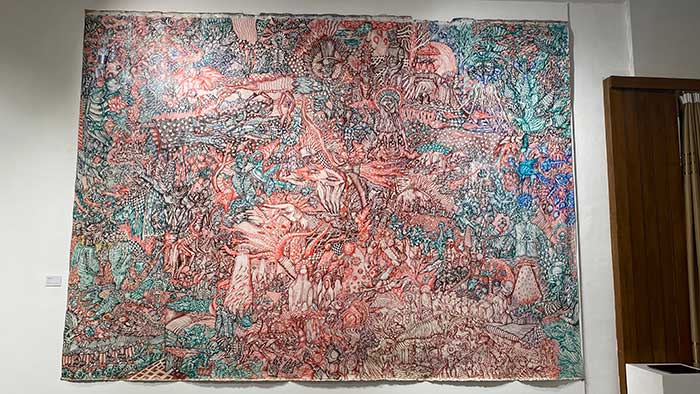By John Anthony S. Estolloso
Spectacularly overwhelming: a cursory glance at Joe Geraldo’s art will give you this impression.
The afternoon of February 24 witnessed the unveiling of the artist’s new exhibit at the Hulot Gallery of the Iloilo Museum of Contemporary Art. Attended by art collectors, fellow artistes, and of course, the crowd of aesthetes and critics who keep the blaze of art appreciation glowing in the city, the vernissage was an aesthetic epiphany: while the ordinary pen may be a humble instrument for making art, it can produce works of sublime dimensions and magnitude if wielded by an imagination powerful enough to render archetypal imagery to newer iterations.
One would have expected a series of canvases rendered with conventional oils or acrylics, or even as assemblages that have become the conventional in local art exhibits. But there are none of these. Instead, sprawled in gargantuan dimensions and inundated to the brim (or should it be margins?) of paper and canvas are Geraldo’s sketches, scrawlings, and doodlings of figures and images in sundry depictions and projections. The visual combination of vastness of breadth and depth of imagery is exhilarating – yet even that would be an understatement.
A closer look at the mishmash of images depicted in Geraldo’s ink-on-paper or canvas art reveals a juxtaposition of the archetypal with the phantasmagorical. Almost lurid in some scenes, they evoke a surfacing of repressed narratives which are rather visible in social contexts: one subconsciously gets the impression of an immensely profound scribbling done during a dragging lecture on Contemporary Issues.
Stealing the spotlight (quite literally) of the gallery would be the artist’s The Fields of Lies and Hates. Reminiscent of Hieronymus Bosch’s panels of earthly and hellish delights, the massive sheet of canvas overflows with the odds and ends of humanity: the anthropomorphized figures of beast and man, the personifications of swine and snakes, the face of beings disfigured with multiple duplications of the sense organs, the repetition of masks to almost nightmarish intensities, the distortion and contortion of the human form, the recurring projections of flames and Furies, the geometry of structures and strictures, the drowning of faces in riverine patterns and checks, the erotic nuances and postures put side by side with religious symbolism – and all these rendered with black ink.
Geraldo’s Psychedelic Dream is a colorized rendition of the above, running on very much the same lines. In hues of red, green, blue, and brown, the same images inundate the canvas: visible is the recurring variant of a man sporting a top hat albeit with a more pronounced political design; there are more faces distorted and contorted painfully, put together like the dramatis personae of an eldritch kabuki performance. Smaller figures congregate in grotesque postures, portraying scenes that might have come out straight from a tale by H.P. Lovecraft or H.G. Wells. Through it all, the ink sits ‘comfortably numb’, coagulated to the freezing point of apathy.
The viewer senses an eerie familiarity with what the artist wants him or her to see. Similarly, Geraldo’s smaller works restate much of the same themes on social issues and the inquiry into the human condition.
For instance, his framed sketches on paper reiterate the timeless questions of our contemporary humanity: with the politics, technology, and religiosity of the times infused in our worldviews, what truly makes modern man – or to push it further, the modern Filipino?
And as if to hyperbolize the social ills that continue to plague the country, Geraldo allegorizes these through more figurative distortions and contortions: human figures twisted in all possible angles and poses and embellished with lifeless accoutrements heighten the wretchedness and misery, and the dry, humorless wit with which we deal with these.
*****
Truly yours missed the opportunity to hear the artist talk about his art on the following day. However, the meanings of what are displayed in Hulot Gallery are quite clear in the most overwhelmingly manner. They disturb and overwhelm but they also invite us to go beyond the thinking lest we just might become too comfortably numb looking at them.
(The writer is the subject area coordinator for Social Studies in one of the private schools in the city; the photos are from ILOMOCA, Kristoffer Brasileño, and razsalvarita.com.]




























